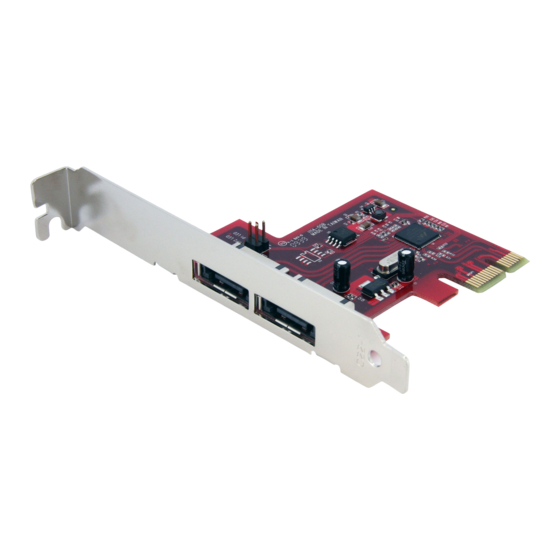Summary of Contents for StarTech.com PEXESAT32
- Page 1 PEXESAT32 PEXSAT32 Instruction Manual PCI Express Serial ATA Adapter Card 2-Port SATA 6Gbps PCI Express eSATA Controller Card 2-Port SATA 6Gbps PCI Express SATA Controller Card...
- Page 2 StarTech.com. Where they occur these references are for illustrative purposes only and do not represent an endorsement of a product or service by StarTech.com, or an endorsement of the product(s) to which this manual applies by the third-party company in question.
-
Page 3: Table Of Contents
Table of Contents Introduction ..............1 Packaging Contents..............1 System Requirements ..............1 PEXESAT32 View ................2 PEXSAT32 View ................2 Installation ............... 3 Hardware Installation ..............3 Driver Installation .................4 Verifying Installation ..............5 Specifications ..............6 Technical Support ............7 Warranty Information ............7... -
Page 4: Introduction
Introduction The StarTech.com 2-Port PCI Express 6Gbps eSATA or SATA Controller Cards offers simple connectivity between a host computer system and eSATA or SATA revision 3.0 devices. A cost-effective solution for connecting high RPM hard drives and Solid State Drives (SSD), which in turn allows for easier data backups and archiving. -
Page 5: Pexesat32 View
PEXESAT32 View LED header connector eSATA connector PEXSAT32 View LED header connector SATA connector... -
Page 6: Installation
Be sure that you are properly grounded before opening your computer case or touching your PCI Express card. StarTech.com recommends that you wear an anti-static strap when installing any computer component. If an anti-static strap... -
Page 7: Driver Installation
Insert the power cable into the socket on the power supply and reconnect all other connectors removed in Step 1. Driver Installation Windows XP/Server 2003/Vista/Server 2008 R2 After installing the card into the computer system, boot up the computer. Once logged into Windows, the Hardware/Driver installation wizard should appear. -
Page 8: Verifying Installation
Verifying Installation Windows XP/Server 2003/Vista/Server 2008 R2/7 From the main desktop, right-click on “My Computer” (“Computer” in Vista or later), then select “Manage”. In the new Computer Management window, select Device Manager from the left window panel. Under the “SCSI and RAID Controllers” category (“Storage Controllers” in Vista or later), should be a “Marvell 91xx”... -
Page 9: Specifications
Specifications PCI Express rev 2.0 (x1 connector) Bus Interface SATA rev 3.0 2 x 7-pin eSATA (PEXESAT32) Connectors 2 x 7-pin SATA (PEXSAT32) Chipset ID Marvell 9128 Maximum Data Transfer Rate SATA: 6Gbps RAID Support 0, 1, JBOD (single) Operating Temperature 5°C ~ 50°C (41°F ~ 122°F) -
Page 10: Technical Support
Limitation of Liability In no event shall the liability of StarTech.com Ltd. and StarTech.com USA LLP (or their officers, directors, employees or agents) for any damages (whether direct or indirect, special, punitive, incidental, consequential, or... - Page 11 StarTech.com has been making “hard-to-find easy” since 1985, providing high quality solutions to a diverse IT and A/V customer base that spans many channels, including government, education and industrial facilities to name just a few. We offer an unmatched selection of computer parts, cables, A/V products, KVM and Server...














Need help?
Do you have a question about the PEXESAT32 and is the answer not in the manual?
Questions and answers